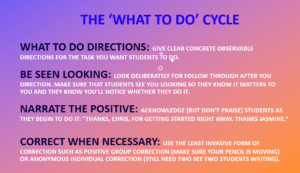03.23.23The ‘What To Do’ Cycle and Other Secrets of Positive Classroom Culture (w/ video)

One of the challenges of good classroom management is that it’s often practically invisible- it’s happening off stage or on the margins of the stage; it’s usually built into habits and expectations. When it works it’s hard to see the moves that make it possible. When you can see the behavior management moves, it’s sometimes all you can see and the larger culture of positivity and productivity gets lost.
But the video I’d like to share today is, I hope, an exception.
It’s of Rebecca Olivarez‘ math class at Memphis Rise Academy in Memphis, TN.
I’m going to show it in two parts.
First, here’s a longer segment of Rebecca’s lesson when students are working hard to solve math problems, largely on their own, but where in Rebecca observes their work, interacts supportively with individual students, gathers data carefully and then fixes a common misconception among the class. The classroom is an optimal place to learn. Students feel safe, successful and known, and they learn a lot.
Here’s the clip:
How does she do it? How is she so successful at getting everyone productively and positively engaged?
One key is something my colleague Darryl Williams calls the “‘What To Do’ Cycle.”
The best teachers we’ve studied use this cycle, or a variation of it, with consistency throughout their lessons to build a warm, supportive culture of follow-through. The 4 key components are:
- What To Do Directions: Give clear concrete observable directions for the task you want students to do.
- Be Seen Looking: Look deliberately for follow through after you direction. Make sure that students see you lookingso they know it matters to you and they know you’ll notice whether they do it.
- Narrate the Positive: Acknowledge (but don’t praise) students as they begin to do it: “Thanks, Chris, for getting started right away. Thanks Jasmine.”
- Correct When Necessary: Use the Least Invasive form of correction such as Positive Group Correction (Make sure your pencil is moving) or Anonymous Individual Correction (Still need two see two students writing).
Here’s the equation: WTD –> BSL –> Narrate –> Correct When Necessary (using Least Invasives)
Consistency is important. When you do it consistently you can be subtle and fast.
In light of that here is a re-cut of Rebecca’s video above showing the the three times she uses the What To Do Cycle within this short segment.
As you can see, one of the keys to her successful classroom culture is her attentiveness to her direction giving. Each time: clear, crisp observable direction, scan for follow-through, acknowledge productive follow-though, correct if necessary (by now, it rarely is).
As in:
- WTD: “Find this statement in your work and box it.”
- BSL: Rebecca scans from the doc cam (using a Swivel) to ensure students are following through
- Narrate: “Thanks, Mario for doing this.”
- Correct: Positive Group Correction: “I should see pencils moving.”
Now you know the secret. 🙂
